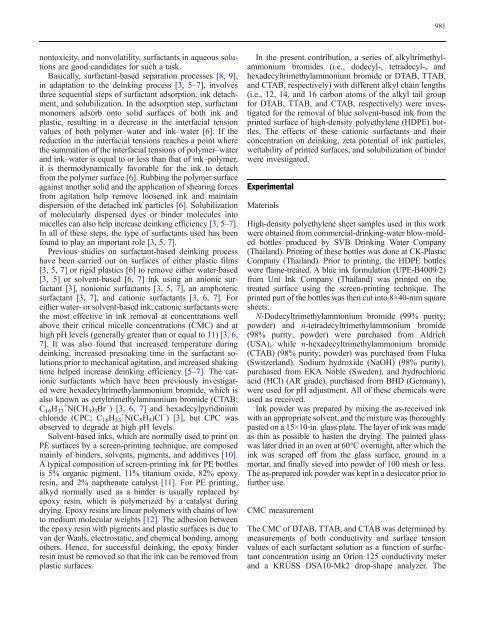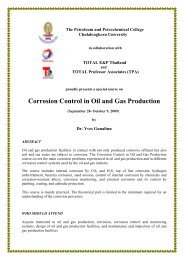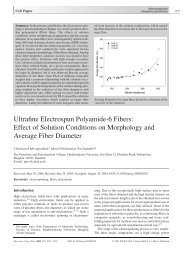Removal of solvent-based ink from printed surface of HDPE bottles ...
Removal of solvent-based ink from printed surface of HDPE bottles ...
Removal of solvent-based ink from printed surface of HDPE bottles ...
You also want an ePaper? Increase the reach of your titles
YUMPU automatically turns print PDFs into web optimized ePapers that Google loves.
nontoxicity, and nonvolatility, surfactants in aqueous solutions<br />
are good candidates for such a task.<br />
Basically, surfactant-<strong>based</strong> separation processes [8, 9],<br />
in adaptation to the de<strong>ink</strong>ing process [3, 5–7], involves<br />
three sequential steps <strong>of</strong> surfactant adsorption, <strong>ink</strong> detachment,<br />
and solubilization. In the adsorption step, surfactant<br />
monomers adsorb onto solid <strong>surface</strong>s <strong>of</strong> both <strong>ink</strong> and<br />
plastic, resulting in a decrease in the interfacial tension<br />
values <strong>of</strong> both polymer–water and <strong>ink</strong>–water [6]. If the<br />
reduction in the interfacial tensions reaches a point where<br />
the summation <strong>of</strong> the interfacial tensions <strong>of</strong> polymer–water<br />
and <strong>ink</strong>–water is equal to or less than that <strong>of</strong> <strong>ink</strong>–polymer,<br />
it is thermodynamically favorable for the <strong>ink</strong> to detach<br />
<strong>from</strong> the polymer <strong>surface</strong> [6]. Rubbing the polymer <strong>surface</strong><br />
against another solid and the application <strong>of</strong> shearing forces<br />
<strong>from</strong> agitation help remove loosened <strong>ink</strong> and maintain<br />
dispersion <strong>of</strong> the detached <strong>ink</strong> particles [6]. Solubilization<br />
<strong>of</strong> molecularly dispersed dyes or binder molecules into<br />
micelles can also help increase de<strong>ink</strong>ing efficiency [3, 5–7].<br />
In all <strong>of</strong> these steps, the type <strong>of</strong> surfactants used has been<br />
found to play an important role [3, 5, 7].<br />
Previous studies on surfactant-<strong>based</strong> de<strong>ink</strong>ing process<br />
have been carried out on <strong>surface</strong>s <strong>of</strong> either plastic films<br />
[3, 5, 7] or rigid plastics [6] to remove either water-<strong>based</strong><br />
[3, 5] or <strong>solvent</strong>-<strong>based</strong> [6, 7] <strong>ink</strong> using an anionic surfactant<br />
[3], nonionic surfactants [3, 5, 7], an amphoteric<br />
surfactant [3, 7], and cationic surfactants [3, 6, 7]. For<br />
either water- or <strong>solvent</strong>-<strong>based</strong> <strong>ink</strong>, cationic surfactants were<br />
the most effective in <strong>ink</strong> removal at concentrations well<br />
above their critical micelle concentrations (CMC) and at<br />
high pH levels (generally greater than or equal to 11) [3, 6,<br />
7]. It was also found that increased temperature during<br />
de<strong>ink</strong>ing, increased presoaking time in the surfactant solutions<br />
prior to mechanical agitation, and increased shaking<br />
time helped increase de<strong>ink</strong>ing efficiency [5–7]. The cationic<br />
surfactants which have been previously investigated<br />
were hexadecyltrimethylammonium bromide, which is<br />
also known as cetyltrimethylammonium bromide (CTAB;<br />
C 16H 33 + N(CH3) 3Br − )[3, 6, 7] and hexadecylpyridinium<br />
chloride (CPC; C 16H 33 + N(C5H 5)Cl − ) [3], but CPC was<br />
observed to degrade at high pH levels.<br />
Solvent-<strong>based</strong> <strong>ink</strong>s, which are normally used to print on<br />
PE <strong>surface</strong>s by a screen-printing technique, are composed<br />
mainly <strong>of</strong> binders, <strong>solvent</strong>s, pigments, and additives [10].<br />
A typical composition <strong>of</strong> screen-printing <strong>ink</strong> for PE <strong>bottles</strong><br />
is 5% organic pigment, 11% titanium oxide, 82% epoxy<br />
resin, and 2% napthenate catalyst [11]. For PE printing,<br />
alkyd normally used as a binder is usually replaced by<br />
epoxy resin, which is polymerized by a catalyst during<br />
drying. Epoxy resins are linear polymers with chains <strong>of</strong> low<br />
to medium molecular weights [12]. The adhesion between<br />
the epoxy resin with pigments and plastic <strong>surface</strong>s is due to<br />
van der Waals, electrostatic, and chemical bonding, among<br />
others. Hence, for successful de<strong>ink</strong>ing, the epoxy binder<br />
resin must be removed so that the <strong>ink</strong> can be removed <strong>from</strong><br />
plastic <strong>surface</strong>s.<br />
In the present contribution, a series <strong>of</strong> alkyltrimethylammonium<br />
bromides (i.e., dodecyl-, tetradecyl-, and<br />
hexadecyltrimethylammonium bromide or DTAB, TTAB,<br />
and CTAB, respectively) with different alkyl chain lengths<br />
(i.e., 12, 14, and 16 carbon atoms <strong>of</strong> the alkyl tail group<br />
for DTAB, TTAB, and CTAB, respectively) were investigated<br />
for the removal <strong>of</strong> blue <strong>solvent</strong>-<strong>based</strong> <strong>ink</strong> <strong>from</strong> the<br />
<strong>printed</strong> <strong>surface</strong> <strong>of</strong> high-density polyethylene (<strong>HDPE</strong>) <strong>bottles</strong>.<br />
The effects <strong>of</strong> these cationic surfactants and their<br />
concentration on de<strong>ink</strong>ing, zeta potential <strong>of</strong> <strong>ink</strong> particles,<br />
wettability <strong>of</strong> <strong>printed</strong> <strong>surface</strong>s, and solubilization <strong>of</strong> binder<br />
were investigated.<br />
Experimental<br />
Materials<br />
High-density polyethylene sheet samples used in this work<br />
were obtained <strong>from</strong> commercial-dr<strong>ink</strong>ing-water blow-molded<br />
<strong>bottles</strong> produced by SVB Dr<strong>ink</strong>ing Water Company<br />
(Thailand). Printing <strong>of</strong> these <strong>bottles</strong> was done at CK-Plastic<br />
Company (Thailand). Prior to printing, the <strong>HDPE</strong> <strong>bottles</strong><br />
were flame-treated. A blue <strong>ink</strong> formulation (UPE-B4009/2)<br />
<strong>from</strong> Uni Ink Company (Thailand) was <strong>printed</strong> on the<br />
treated <strong>surface</strong> using the screen-printing technique. The<br />
<strong>printed</strong> part <strong>of</strong> the <strong>bottles</strong> was then cut into 8×40-mm square<br />
sheets.<br />
N-Dodecyltrimethylammonium bromide (99% purity;<br />
powder) and n-tetradecyltrimethylammonium bromide<br />
(98% purity; powder) were purchased <strong>from</strong> Aldrich<br />
(USA), while n-hexadecyltrimethylammonium bromide<br />
(CTAB) (98% purity; powder) was purchased <strong>from</strong> Fluka<br />
(Switzerland). Sodium hydroxide (NaOH) (98% purity),<br />
purchased <strong>from</strong> EKA Noble (Sweden), and hydrochloric<br />
acid (HCl) (AR grade), purchased <strong>from</strong> BHD (Germany),<br />
were used for pH adjustment. All <strong>of</strong> these chemicals were<br />
used as received.<br />
Ink powder was prepared by mixing the as-received <strong>ink</strong><br />
with an appropriate <strong>solvent</strong>, and the mixture was thoroughly<br />
pasted on a 15×10-in. glass plate. The layer <strong>of</strong> <strong>ink</strong> was made<br />
as thin as possible to hasten the drying. The painted glass<br />
was later dried in an oven at 60°C overnight, after which the<br />
<strong>ink</strong> was scraped <strong>of</strong>f <strong>from</strong> the glass <strong>surface</strong>, ground in a<br />
mortar, and finally sieved into powder <strong>of</strong> 100 mesh or less.<br />
The as-prepared <strong>ink</strong> powder was kept in a desiccator prior to<br />
further use.<br />
CMC measurement<br />
981<br />
The CMC <strong>of</strong> DTAB, TTAB, and CTAB was determined by<br />
measurements <strong>of</strong> both conductivity and <strong>surface</strong> tension<br />
values <strong>of</strong> each surfactant solution as a function <strong>of</strong> surfactant<br />
concentration using an Orion 125 conductivity meter<br />
and a KRÜSS DSA10-Mk2 drop-shape analyzer. The





